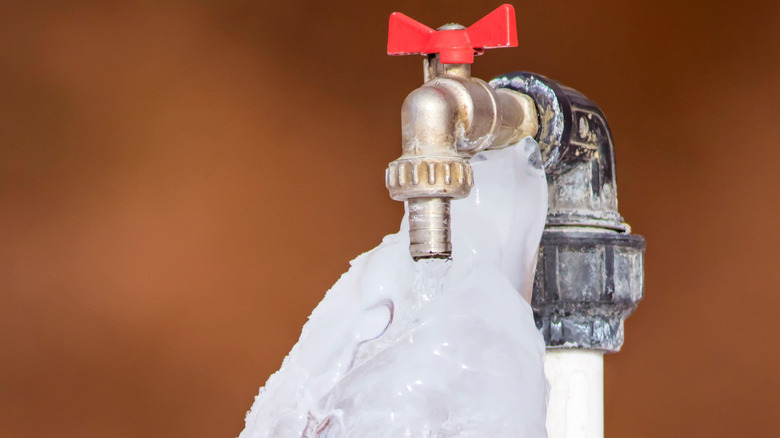Important Tips to Protect Against Frozen Plumbing in Cold Weather
Important Tips to Protect Against Frozen Plumbing in Cold Weather
Blog Article
The author is making a few great pointers related to Preventing and dealing with frozen pipes overall in this article down below.

Winter can ruin your pipes, specifically by freezing pipes. Here's just how to prevent it from occurring and what to do if it does.
Intro
As temperatures decline, the danger of icy pipes boosts, potentially causing costly repair services and water damage. Recognizing how to avoid icy pipes is crucial for house owners in cool climates.
Comprehending Icy Pipelines
What causes pipes to freeze?
Pipes ice up when exposed to temperature levels listed below 32 ° F (0 ° C) for expanded durations. As water inside the pipelines ices up, it increases, taxing the pipeline walls and potentially triggering them to rupture.
Dangers and damages
Frozen pipes can lead to supply of water interruptions, building damage, and pricey repairs. Ruptured pipes can flooding homes and cause substantial structural damages.
Indications of Frozen Pipes
Determining icy pipelines early can stop them from breaking.
How to recognize icy pipelines
Seek reduced water circulation from faucets, unusual smells or sounds from pipelines, and noticeable frost on revealed pipelines.
Avoidance Tips
Insulating at risk pipes
Cover pipes in insulation sleeves or utilize warmth tape to safeguard them from freezing temperature levels. Focus on pipes in unheated or outside locations of the home.
Heating techniques
Keep indoor rooms properly warmed, especially areas with plumbing. Open cabinet doors to enable warm air to distribute around pipes under sinks.
Securing Outdoor Plumbing
Garden hose pipes and outdoor faucets
Disconnect and drain pipes yard tubes prior to wintertime. Set up frost-proof spigots or cover outdoor faucets with shielded caps.
What to Do If Your Pipelines Freeze
Immediate actions to take
If you suspect icy pipelines, keep taps open to relieve stress as the ice melts. Use a hairdryer or towels taken in hot water to thaw pipelines slowly.
Long-Term Solutions
Architectural modifications
Consider rerouting pipelines far from outside walls or unheated locations. Add added insulation to attics, basements, and crawl spaces.
Upgrading insulation
Buy premium insulation for pipes, attic rooms, and wall surfaces. Appropriate insulation helps preserve regular temperature levels and reduces the threat of icy pipelines.
Verdict
Avoiding frozen pipes calls for proactive steps and fast feedbacks. By understanding the causes, signs, and preventive measures, home owners can protect their plumbing throughout winter.
6 Proven Ways to Prevent Frozen Pipes and Protect Your Home
Disconnect and Drain Garden Hoses
Before winter arrives, start by disconnecting your garden hoses and draining any remaining water. Close the shut-off valves that supply outdoor hose bibs and leave the outdoor faucet open to allow any residual water to drain. For extra protection, consider using faucet covers throughout the colder months. It’s also important to drain water from any sprinkler supply lines following the manufacturer’s directions.
Insulate Exposed Pipes
Insulating your pipes is an effective way to prevent freezing. Pipe insulation is readily available at home improvement stores and is relatively inexpensive. Pay close attention to pipes in unheated areas such as the attic, basement, crawl spaces, or garage. Apply foam insulation generously to create a buffer against the cold. You can also wrap your pipes in heat tape or thermostat-controlled heat cables for added warmth.
Seal Air Leaks
Inspect your home for any cracks or openings that could let in cold air. Seal any holes around the piping in interior or exterior walls, as well as the sill plates where your home rests on its foundation. Additionally, make sure to keep your garage door closed unless you’re entering or exiting. Leaving it open creates a significant air leak that can lead to frozen pipes.
Allow Warm Air Circulation
During cold snaps, it’s essential to allow warm air to circulate evenly throughout your home. Leave interior doors ajar to promote better airflow. Open kitchen and bathroom cabinets to help distribute heat consistently around the rooms. If you have small children or pets, be sure to remove any household chemicals or potentially harmful cleaners from open cabinets for safety.
Let Faucets Drip
A small trickle of water can make a big difference in preventing ice formation inside your pipes. When temperatures drop significantly, start a drip of water from all faucets served by exposed pipes. This continuous flow helps prevent the water from freezing. Additionally, running a few faucets slightly can relieve pressure inside the pipes, reducing the chances of a rupture if the water inside does freeze.
https://choateshvac.com/6-proven-ways-to-prevent-frozen-pipes-and-protect-your-home/

Do you like more info about How To Avoid Freezing Pipes? Create a short review down the page. We will be glad to listen to your ideas about this content. We are looking forward that you visit us again soon. Sharing is caring. You never know, you may just be doing someone a favor. Thanks for being here. Kindly stop by our website back soon.
Request An Appointment Report this page